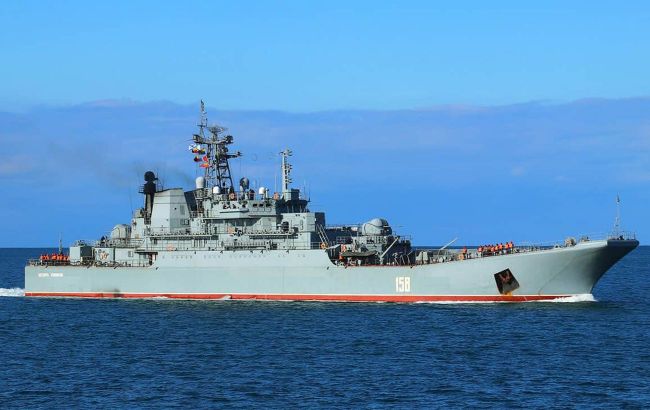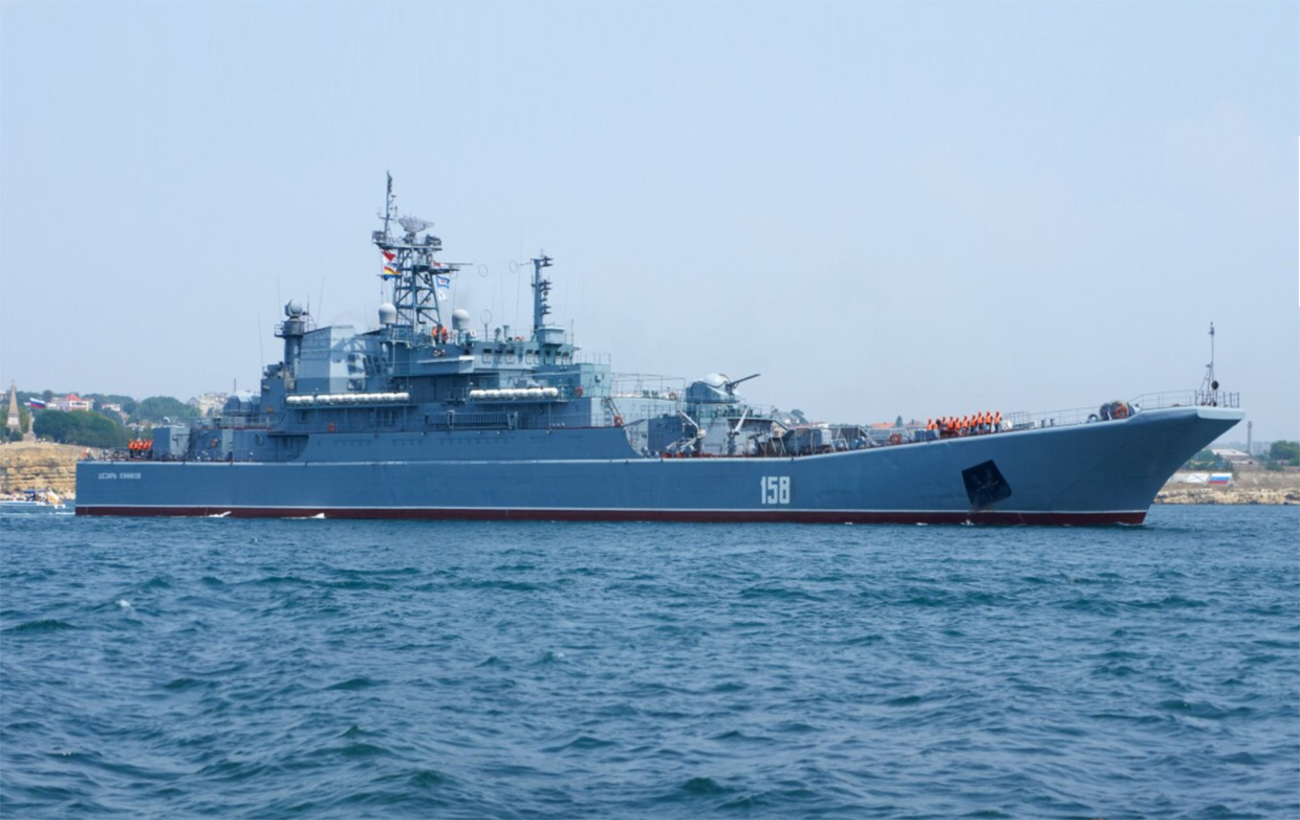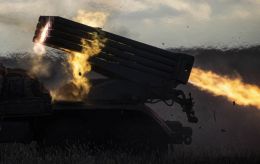Butterfly effect: Frontline impact of strikes on Russian ships and landing crafts remaining to sink
 Ukraine has destroyed a large Russian landing ship Tsezar Kunikov (Photo: mill.ru)
Ukraine has destroyed a large Russian landing ship Tsezar Kunikov (Photo: mill.ru)
Ukrainian forces successfully attacked another Russian large landing ship. This time it was the Tsezar Kunikov, which sank near the coast of occupied Crimea.
Find out more about how the Navy's drones sank the Tsezar Kunikov, why such targets are particularly important, and how the loss of ships could weaken Russia in the material by RBС-Ukraine.
In preparing the material, data from the Telegram channel Crimean Wind, information from the General Staff of the Armed Forces of Ukraine, statements from military spokespersons, a representative of the Defense Intelligence Andrii Yusov, material from Defense Express, and comments from expert Volodymyr Zablotskyi were used.
Attack at sea: What happened to the Tsezar Kunikov large landing ship
On the morning of February 14, news of explosions was reported by residents of Yalta and Alupka in Crimea. Witnesses described flashes at sea followed by explosions. Windows in Alupka were reported to have opened due to the blast wave, and an alarm sounded on one of the ships.
Later, a video emerged showing detonations on a large landing ship, which was attacked and sank. Explosions continued even after the vessel went underwater. Occupying authorities dispatched helicopters for search and rescue operations.
Within hours, a statement from the General Staff of the Armed Forces of Ukraine confirmed a joint operation with military intelligence resulting in the destruction of the large landing ship Tsezar Kunikov. The ship was attacked while in Ukrainian territorial waters near Alupka.
According to Ukrainian military intelligence, the enemy ship was attacked by naval drones, causing critical breaches along the left side, leading to its sinking.
"It's symbolic that the ship was named after a Russian officer who was killed exactly 81 years ago," noted intelligence sources.
Named after Tsezar Kunikov, a Soviet officer who commanded the landing and capture of the Malaya Zemlya (Small Land) bridgehead near Novorossiysk during World War II, the ship is now irreparably destroyed.
Commenting on the situation with the large landing ship, Ukrainian Navy spokesperson Dmytro Pletenchuk stated that colleagues from military intelligence once again eliminated an "unnecessary object in the Black Sea." He ironically referred to the coincidence in dates as a "poor success," quipping that "not every Caesar manages to die twice in one day."
Regarding the aftermath, a representative of Ukrainian military intelligence Andrii Yusov stated that most of the crew did not survive.
"The ship was carrying cargo - ammunition. The Tsezar Kunikov has been completely destroyed, sunk, and cannot be salvaged," he added.
In a conversation with journalists, Yusov humorously referred to the attack as a "Valentine's Day gift" from Ukrainians.
"These are challenging times indeed. However, even in these challenging times, Ukrainian men and women have the right to celebrate. Therefore, the Defense Intelligence of Ukraine and all components of the Ukrainian Armed Forces extend their warm wishes to Ukrainians on Valentine's Day... Tsezar Kunikov is now at the bottom, and everyone is pleased with that," he said.
As of 19:00, the Russian side has not officially confirmed the loss of the large landing ship. Vladimir Putin's press secretary, Dmitry Peskov, redirected all questions to the Ministry of Defense in communication with Russian media. However, reconnaissance intercepted conversations of the rescue helicopter crew discussing debris and an oil slick in the sea.
The anonymous Telegram channel Kremlin's Tabakerka writes that supposedly there were six T-90 and T-72 tanks on board, as well as tank shells and artillery shells intended for the combat zone. Allegedly, the bodies of four deceased individuals were also found, with another 12 crew members considered missing. According to military intelligence, Tsezar Kunikov had been stationed for 10 days prior to the attack, and preliminary data suggests it was loaded at the time of the strike.
Military expert, and Defense Express analyst Volodymyr Zablotskyi says that the attack by unmanned boats followed all the classic tactics and guidelines of the genre.
"Five or six units arrived at the 'rendezvous point,' calculated based on reconnaissance data, attacked from different directions, and inflicted damage incompatible with life. After that, the ship exploded and sank. It's the same tactic used in the sinking of the missile boat Ivanovets (sunk on the night of February 1 - Ed.)," he notes in a comment to RBC-Ukraine.
For more details on the attack on the Ivanovets boat, see a separate article.
Key points about the large landing ship Tsezar Kunikov
Tsezar Kunikov is a large landing ship of Project 775, commissioned in 1986. During the Soviet era, it was part of the 197th Brigade of the 39th Division based in Novoozernoye (Crimea), Donuzlav. During the distribution of the Black Sea Fleet between Ukraine and the Russian Federation, it moved to the Russian base in Sevastopol.
It participated in the peacekeeping operation KFOR in Kosovo (1999), the war against Georgia in 2008, and in the mid-2010s, in supplying the Syrian government army with weapons and ammunition. Since 2022, it has been involved in Russia's full-scale invasion of Ukraine.
According to Zablotskyi, Tsezar Kunikov is identical to the previously destroyed large landing ships Novocherkassk and Minsk.
"They are like twins, all built at the Stocznia Polnocna shipyard in Gdansk, Poland, in the late 1980s. They are far from new, but Russia has nothing better. Overall, before the invasion, they assembled a mixed bag of large landing ships from three fleets in the Black Sea. And we can say that we inflicted losses not only on the Black Sea Fleet but also on the Baltic and Northern Fleets," he explains in an interview with the news agency.
 Photo: The large landing ship Tsezar Kunikov is a twin brother of other sunken large landing ships (wikipedia.org)
Photo: The large landing ship Tsezar Kunikov is a twin brother of other sunken large landing ships (wikipedia.org)
Tsezar Kunikov is no stranger to being targeted. In particular, on the morning of March 24, 2022, Ukrainian Tochka-U missiles targeted ships in the port of occupied Berdyansk.
"The large landing ship Saratov was destroyed, with Tsezar Kunikov and Novocherkassk standing nearby, waiting to be unloaded. They sustained damage, caught fire, urgently unmoored, and fled," notes an expert.
It was later revealed that the commander, Alexander Chirva, died, presumably from injuries sustained. The large landing ship returned to service after a year of repairs.
Key characteristics:
- Displacement - 3,450 tons (normal), 4,080 tons (full load)
- Length - 112.5 meters
- Width - 15 meters
- Draft - 3.7 meters
- Engines - two diesel engines with 10,500 horsepower each
- Speed - 17.8 knots (33 km/h)
- Range - 6,000 nautical miles (over 11,000 kilometers) at 12 knots (22 km/h)
- Crew - 87 people
The standard armament for Project 775 large landing ships includes two Grad-M multiple rocket launchers for shelling coastal fortifications, two paired AK-725 artillery mounts with remote guidance, or an artillery complex with one AK-176 mount and two AK-630M mounts. Their presence on the Tsezar Kunikov proved ineffective against Ukrainian surface drones.
How Ukrainian forces sank another large landing ship
As reported by intelligence, Tsezar Kunikov was attacked by Magura V5 surface drones. The specialized news agency Defense Express provides a detailed analysis of the strike. The first drone approached from the shore to strike the large landing ship in the bow, which is a vulnerable area. Based on the video, there were no automatic gun systems in operation, and instead, sailors attempted to shoot down the drone with rifles. The result was quite predictable, and most likely, the first Magura V5 made a breach in the main hold.
The second drone struck from the sea side, and it was also unsuccessfully targeted with rifles. The strike from the opposite side hit the compartment with the power plant in the last third of the hull. Then a third drone was directed there, while the fourth recorded the large landing ship already listing significantly on video.
Once again, the Ukrainian fleet of surface drones yielded results. However, it's premature to call them the most effective weapons against Russian ships, according to Volodymyr Zablotskyi.
"We still have air and coastal-based cruise missiles, which are also powerful assets. There are naval mines, surface drones of several modifications, and even underwater drones. We're waiting to see how underwater UAVs will perform. There have been talks about attempts to mine Sevastopol; even a boat exploded last year (in October 2023, the boat Vladimir Kozitsky exploded in the outer raid of Sevastopol Bay, - Ed.). There was no confirmation, but it can be assumed that if it did happen, a submersible carrier delivered the mine there. So, at the right moment for us, we can lay mines, and the enemy won't even know about it," explains the expert.
For more details about the Ukrainian Magura V5 drones, refer to a separate material by RBC-Ukraine.
Regarding the detonation on the large landing ship Tsezar Kunikov, Zablotskyi speculates that it might have been carrying more than just ammunition.
"Near the area where it was shot down is Cape Chauda - one of the launch sites for Shahed drones over Ukraine. How do they get to the Black Sea? Through the Caspian Sea from Iran, then by rail to Novorossiysk, and then by sea to Crimea. As an option, the same could have happened with the large landing ship 'Novocherkassk' near Feodosia in December," he adds.
How many more large landing ships are in the Black Sea and how their destruction affects Russia's logistics
Tsezar Kunikov became the fourth Russian large landing ship sunk by the Ukrainian Defense Forces. Prior to that, on the night of December 26, Novocherkassk was destroyed by a Storm Shadow strike, as was Minsk on September 13 at the Sevastopol plant, and Saratov went down due to a Tochka-U attack in March 2022. The fifth ship, Olenegorsky Gornyak, was hit by drones near Novorossiysk in the summer of 2023.

The loss of the large landing ship Tsezar Kunikov will weaken Russian military logistics (Photo: Russian media)
According to Ukrainian Navy spokesman Dmytro Pletenchuk, after the destruction of the Tsezar Kunikov, only five out of 13 ships of the Russian Black Sea Fleet remain in service. However, regarding large landing ships of various projects, including those assigned to other fleets, the current composition of large landing ships consists of eight vessels:
- Project 11711 ship Pyotr Morgunov (Northern Fleet)
- Two Project 1171 ships Nikolay Filchenkov and Orsk (both in the Black Sea Fleet)
- Five Project 775 ships Yamal and Azov (both in the Black Sea Fleet), Korolev and Kaliningrad (both in the Baltic Fleet), and Georgii Pobedonosets (Northern Fleet).
"At the beginning of the invasion, there were 13 large landing ships, five of which are now out of commission and will not return. Out of these eight, two are under repair. So that's all that's left," explains Volodymyr Zablotskyi to the agency.
It's worth noting that Russian large landing ships have long ceased to be used for their direct purpose. This is partly due to the impossibility of landing operations due to mined approaches to Ukrainian shores and the presence of anti-ship weapons. Therefore, large landing ships are primarily engaged in military logistics.
From this perspective, strikes on Russian ships serve an important purpose - to disrupt the supply lines of occupation forces. And, most likely, the current year may become significant, especially against the backdrop of hints from the commander of the Ukrainian Navy, Oleksii Neizhpapa, that there will be no Crimean Bridge by 2024. In this regard, the so-called butterfly effect may manifest itself when the loss of a seemingly small element unpredictably affects the battlefield.
"Attacks on large ships can obviously be considered one of the stages of disrupting logistics. This is an important element that occupiers use to supply the garrison in Crimea and beyond. If we disrupt logistics, tanks will stop or there will be nothing to shoot on the front line. As for the Crimean Bridge, anything is possible. Let's see, the year has just begun and started well," adds the expert.

